Accuracy and Validity of Resting Energy Expenditure Predictive Equations in Middle-Aged Adults
Abstract
1. Introduction
2. Materials and Methods
2.1. Participants
2.2. Body Composition
2.3. Resting Energy Expenditure Assessment by Indirect Calorimetry
2.4. REE Predictive Equations
2.5. Statistical Analysis
3. Results
4. Discussion
5. Conclusions
Supplementary Materials
Author Contributions
Funding
Acknowledgments
Conflicts of Interest
References
- Smith, K.B.; Smith, M.S. Obesity statistics. Prim. Care Clin. Off. Pract. 2016, 43, 121–135. [Google Scholar] [CrossRef] [PubMed]
- Fleming, T.; Robinson, M.; Thomson, B.; Graetz, N.; Margono, C.; Mullany, E.C.; Biryukov, S.; Abbafati, C.; Abera, S.F.; Abraham, J.P. Global, regional, and national prevalence of overweight and obesity in children and adults during 1980–2013: A systematic analysis for the Global Burden of Disease Study. Lancet 2013, 384, 766–781. [Google Scholar]
- Noreik, M.; Maurmann, M.; Meier, V.; Becker, I.; Röhrig, G.; Polidori, M.C.; Schulz, R.-J. Resting energy expenditure (REE) in an old-old population: Implications for metabolic stress. Exp. Gerontol. 2014, 59, 47–50. [Google Scholar] [CrossRef] [PubMed]
- Matarese, L.E. Indirect Calorimetry: Technical Aspects. J. Am. Diet. Assoc. 1997, 97, S154–S160. [Google Scholar] [CrossRef]
- Blasco Redondo, R. Resting energy expenditure; assessment methods and applications. Nutr. Hosp. 2015, 31, 245–254. [Google Scholar] [PubMed]
- Harris, J.; Benedict, F. A biometric study of basal metabolism in man. Proc. Natl. Acad. Sci. USA 1918, 4, 370–373. [Google Scholar] [CrossRef] [PubMed]
- Roza, A.M.; Shizgal, H.M. The Harris Benedict equation reevaluated: Resting energy requirements and the body cell mass. Am. J. Clin. Nutr. 1984, 40, 168–182. [Google Scholar] [CrossRef] [PubMed]
- Owen, O.E.; Holup, J.L.; D’Alessio, D.A.; Craig, E.S.; Polansky, M.; Smalley, K.J.; Kavle, E.C.; Bushman, M.C.; Owen, L.R.; Mozzoli, M.A. A reappraisal of the caloric requirements of men. Am. J. Clin. Nutr. 1987, 46, 875–885. [Google Scholar] [CrossRef] [PubMed]
- Owen, O.E.; Kavle, E.; Owen, R.S.; Polansky, M.; Caprio, S.; Mozzoli, M.A.; Kendrick, Z.V.; Bushman, M.C.; Boden, G. A reappraisal of caloric requirements in healthy women. Am. J. Clin. Nutr. 1986, 44, 1–19. [Google Scholar] [CrossRef] [PubMed]
- Mifflin, M.D.; St Jeor, S.T.; Hill, L.A.; Scott, B.J.; Daugherty, S.A.; Koh, Y.O. A new predictive equation for resting energy expenditure in healthy individuals. Am. J. Clin. Nutr. 1990, 51, 241–247. [Google Scholar] [CrossRef] [PubMed]
- Livingston, E.H.; Kohlstadt, I. Simplified resting metabolic rate-predicting formulas for normal-sized and obese individuals. Obes. Res. 2005, 13, 1255–1262. [Google Scholar] [CrossRef] [PubMed]
- Schofield, W.N. Predicting basal metabolic rate, new standards and review of previous work. Hum. Nutr. Clin. Nutr. 1985, 39, 5–41. [Google Scholar] [PubMed]
- FAO/WHO/UNU. Energy and Protein Requirements; FAO/WHO: Geneva, Switzerland, 1985. [Google Scholar]
- Henry, C.J.K. Basal metabolic rate studies in humans: Measurement and development of new equations. Public Health Nutr. 2005, 8, 1133–1152. [Google Scholar] [CrossRef] [PubMed]
- Müller, M.J.; Bosy-Westphal, A.; Klaus, S.; Kreymann, G.; Lührmann, P.M.; Neuhäuser-Berthold, M.; Noack, R.; Pirke, K.M.; Platte, P.; Selberg, O.; et al. World Health Organization equations have shortcomings for predicting resting energy expenditure in persons from a modern, affluent population: Generation of a new reference standard from a retrospective analysis of a German database of resting energy expe. Am. J. Clin. Nutr. 2004, 80, 1379–1390. [Google Scholar] [CrossRef] [PubMed]
- Korth, O.; Bosy-Westphal, A.; Zschoche, P.; Glüer, C.C.; Heller, M.; Müller, M.J. Influence of methods used in body composition analysis on the prediction of resting energy expenditure. Eur. J. Clin. Nutr. 2007, 61, 582–589. [Google Scholar] [CrossRef] [PubMed]
- Lorenzo, A.; De Andreoli, A.; Bertoli, S.; Testolin, G.; Oriani, G.; Deurenberg, P. Resting metabolic rate in Italians: Relation with body composition and anthropometric parameters. Acta Diabetol. 2000, 37, 77–81. [Google Scholar] [CrossRef] [PubMed]
- Johnstone, A.M.; Rance, K.A.; Murison, S.D.; Duncan, J.S.; Speakman, J.R. Additional anthropometric measures may improve the predictability of basal metabolic rate in adult subjects. Eur. J. Clin. Nutr. 2006, 60, 1437–1444. [Google Scholar] [CrossRef] [PubMed]
- Weijs, P.J.M. Validity of predictive equations for resting energy expenditure in US and Dutch overweight and obese class I and II adults aged 18–65 y. Am. J. Clin. Nutr. 2008, 88, 959–970. [Google Scholar] [CrossRef] [PubMed]
- Frankenfield, D.C.; Rowe, W.A.; Smith, J.S.; Cooney, R.N. Validation of several established equations for resting metabolic rate in obese and nonobese people. J. Am. Diet. Assoc. 2003, 103, 1152–1159. [Google Scholar] [CrossRef]
- de la Cruz Marcos, S.; de Mateo Silleras, B.; Camina Martín, M.A.; Carreño Enciso, L.; Miján de la Torre, A.; Galgani Fuentes, J.E.; Redondo del Rio, M.P. Proposal for a new formula for estimating resting energy expenditure for healthy Spanish population. Nutr. Hosp. 2015, 32, 2346–2352. [Google Scholar] [PubMed]
- Cunningham, J.J. A reanalysis of the factors influencing basal metabolic rate in normal adults. Am. J. Clin. Nutr. 1980, 33, 2372–2374. [Google Scholar] [CrossRef] [PubMed]
- Huang, K.-C.; Kormas, N.; Steinbeck, K.; Loughnan, G.; Caterson, I.D. Resting Metabolic Rate in Severely Obese Diabetic and Nondiabetic Subjects. Obes. Res. 2004, 12, 840–845. [Google Scholar] [CrossRef] [PubMed]
- De Luis, D.A.; Aller, R.; Izaola, O.; Romero, E. Prediction equation of resting energy expenditure in an adult spanish population of obese adult population. Ann. Nutr. Metab. 2006, 50, 193–196. [Google Scholar] [CrossRef] [PubMed]
- Bernstein, R.S.; Thornton, J.C.; Yang, M.U.; Wang, J.; Redmond, A.M.; Pierson, R.M.; Pi-Sunyer, F.X.; Van Itallie, T.B. Prediction of the resting metabolic rate in obese patients. Am. J. Clin. Nutr. 1983, 37, 595–602. [Google Scholar] [CrossRef] [PubMed]
- Siervo, M.; Bertoli, S.; Battezzati, A.; Wells, J.C.; Lara, J.; Ferraris, C.; Tagliabue, A. Accuracy of predictive equations for the measurement of resting energy expenditure in older subjects. Clin. Nutr. 2014, 33, 613–619. [Google Scholar] [CrossRef] [PubMed]
- Acar-Tek, N.; Ağagündüz, D.; Çelik, B.; Bozbulut, R. Estimation of resting energy expenditure: Validation of previous and new predictive equations in obese children and adolescents. J. Am. Coll. Nutr. 2017, 36, 470–480. [Google Scholar] [CrossRef] [PubMed]
- Wahrlich, V.; Teixeira, T.M.; Anjos, L.A. Validity of a population-specific BMR predictive equation for adults from an urban tropical setting. Clin. Nutr. 2016, 37, 208–213. [Google Scholar] [CrossRef] [PubMed]
- Johannsen, D.; Welk, G.; Sharp, R.; Flakoll, P. Differences in daily energy expenditure in lean and obese women: The role of posture allocation. Obesity 2008, 16, 34–39. [Google Scholar] [CrossRef] [PubMed]
- Amaro-Gahete, F.J.; De-la-O, A.; Jurado-Fasoli, L.; Espuch-Oliver, A.; Robles-González, L.; Navarro-Lomas, G.; de Haro, T.; Femia, P.; Castillo, M.J.; Gutierrez, A. Exercise training as S-Klotho protein stimulator in sedentary healthy adults: Rationale, design, and methodology. Contemp. Clin. Trials Commun. 2018, 11, 10–19. [Google Scholar] [CrossRef] [PubMed]
- World Health Organization. Obesity: Preventing and managing the Global Epidemic. Exec. Summ. WHO Tech. Rep. Ser. 2010, 1997, 5–8. [Google Scholar]
- Compher, C.; Frankenfield, D.; Keim, N.; Roth-Yousey, L. Evidence Analysis Working Group. Best practice methods to apply to measurement of resting metabolic rate in adults: A systematic review. J. Am. Diet. Assoc. 2006, 106, 881–903. [Google Scholar] [CrossRef] [PubMed]
- Fullmer, S.; Benson-Davies, S.; Earthman, C.P.; Frankenfield, D.C.; Gradwell, E.; Lee, P.S.P.; Piemonte, T.; Trabulsi, J. Evidence analysis library review of best practices for performing indirect calorimetry in healthy and non-critically ill individuals. J. Acad. Nutr. Diet. 2015, 115, 1417–1446. [Google Scholar] [CrossRef] [PubMed]
- Sanchez-Delgado, G.; Alcantara, J.M.A.; Ortiz-Alvarez, L.; Xu, H.; Martinez-Tellez, B.; Labayen, I.; Ruiz, J.R. Reliability of resting metabolic rate measurements in young adults: Impact of methods for data analysis. Clin. Nutr. 2017, 37, 1618–1624. [Google Scholar] [CrossRef] [PubMed]
- Weir, J. New methods for calculating metabolic rate with special reference to protein metabolism. J. Physiol. 1949, 109, 1–9. [Google Scholar] [CrossRef] [PubMed]
- Willis, E.A.; Herrmann, S.D.; Ptomey, L.T.; Honas, J.J.; Bessmer, C.T.; Donnelly, J.E.; Washburn, R.A. Predicting resting energy expenditure in young adults. Obes. Res. Clin. Pract. 2014, 8, 201–208. [Google Scholar] [CrossRef] [PubMed]
- Frankenfield, D. Bias and accuracy of resting metabolic rate equations in non-obese and obese adults. Clin. Nutr. 2013, 32, 976–982. [Google Scholar] [CrossRef] [PubMed]
- Ruiz, J.R.; Ortega, F.B.; Rodríguez, G.; Alkorta, P.; Labayen, I. Validity of resting energy expenditure predictive equations before and after an energy-restricted diet intervention in obese women. PLoS ONE 2011. [Google Scholar] [CrossRef] [PubMed]
- Frankenfield, D.; Roth-Yousey, L.; Compher, C. Comparison of predictive equations for resting metabolic rate in healthy nonobese and obese adults: A systematic review. J. Am. Diet. Assoc. 2005, 105, 775–789. [Google Scholar] [CrossRef] [PubMed]
- Bland, J.M.; Altman, D.G. Statistical methods for assessing agreement between two methods of clinical measurement. Lancet 1986, 1, 307–310. [Google Scholar] [CrossRef]
- De Lorenzo, A.; Tagliabue, A.; Andreoli, A.; Testolin, G.; Comelli, M.; Deurenberg, P. Measured and predicted resting metabolic rate in Italian males and females, aged 18–59 y. Eur. J. Clin. Nutr. 2001, 55, 208–214. [Google Scholar] [CrossRef] [PubMed]
- Lazzer, S.; Agosti, F.; Resnik, M.; Marazzi, N.; Mornati, D.; Sartorio, A. Prediction of resting energy expenditure in severely obese Italian males. J. Endocrinol. Investig. 2007, 30, 754–761. [Google Scholar] [CrossRef] [PubMed]
- Weijs, P.J.M.; Vansant, G.A.A.M. Validity of predictive equations for resting energy expenditure in Belgian normal weight to morbid obese women. Clin. Nutr. 2010, 29, 347–351. [Google Scholar] [CrossRef] [PubMed]
- Wright, T.G.; Dawson, B.; Jalleh, G.; Guelfi, K.J. Accuracy of resting metabolic rate prediction in overweight and obese Australian adults. Obes. Res. Clin. Pract. 2016, 10, S74–S83. [Google Scholar] [CrossRef] [PubMed]
- Madden, A.M.; Mulrooney, H.M.; Shah, S. Estimation of energy expenditure using prediction equations in overweight and obese adults: A systematic review. J. Hum. Nutr. Diet. 2016, 29, 458–476. [Google Scholar] [CrossRef] [PubMed]
- Tseng, C.-K.; Hsu, H.-S.; Ho, C.-T.; Huang, H.-Y.; Liu, C.-S.; Lin, C.-C.; Lin, W.-Y. Predictive equation of resting energy expenditure in obese adult Taiwanese. Obes. Res. Clin. Pract. 2011, 5, e313–e319. [Google Scholar] [CrossRef] [PubMed]
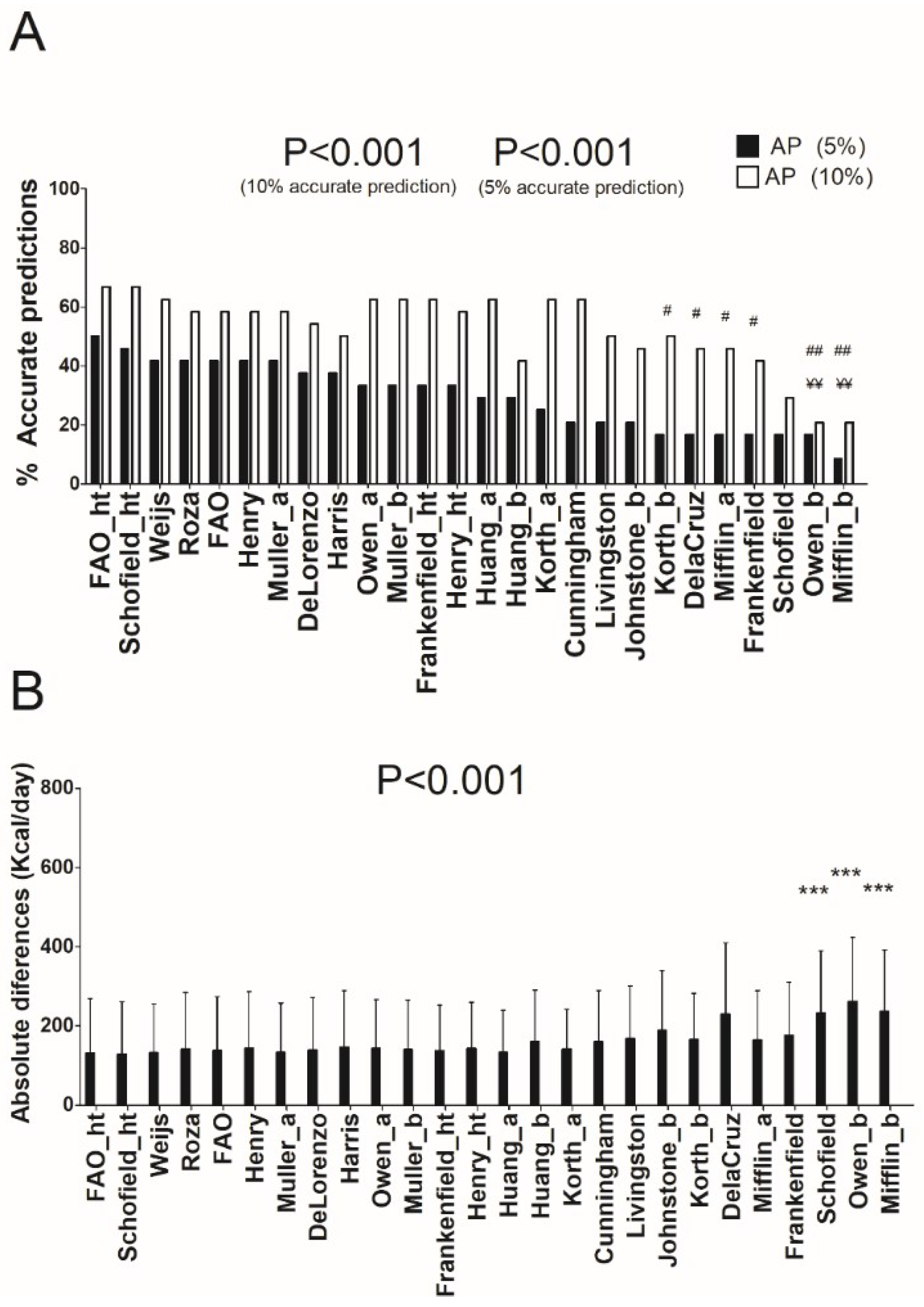
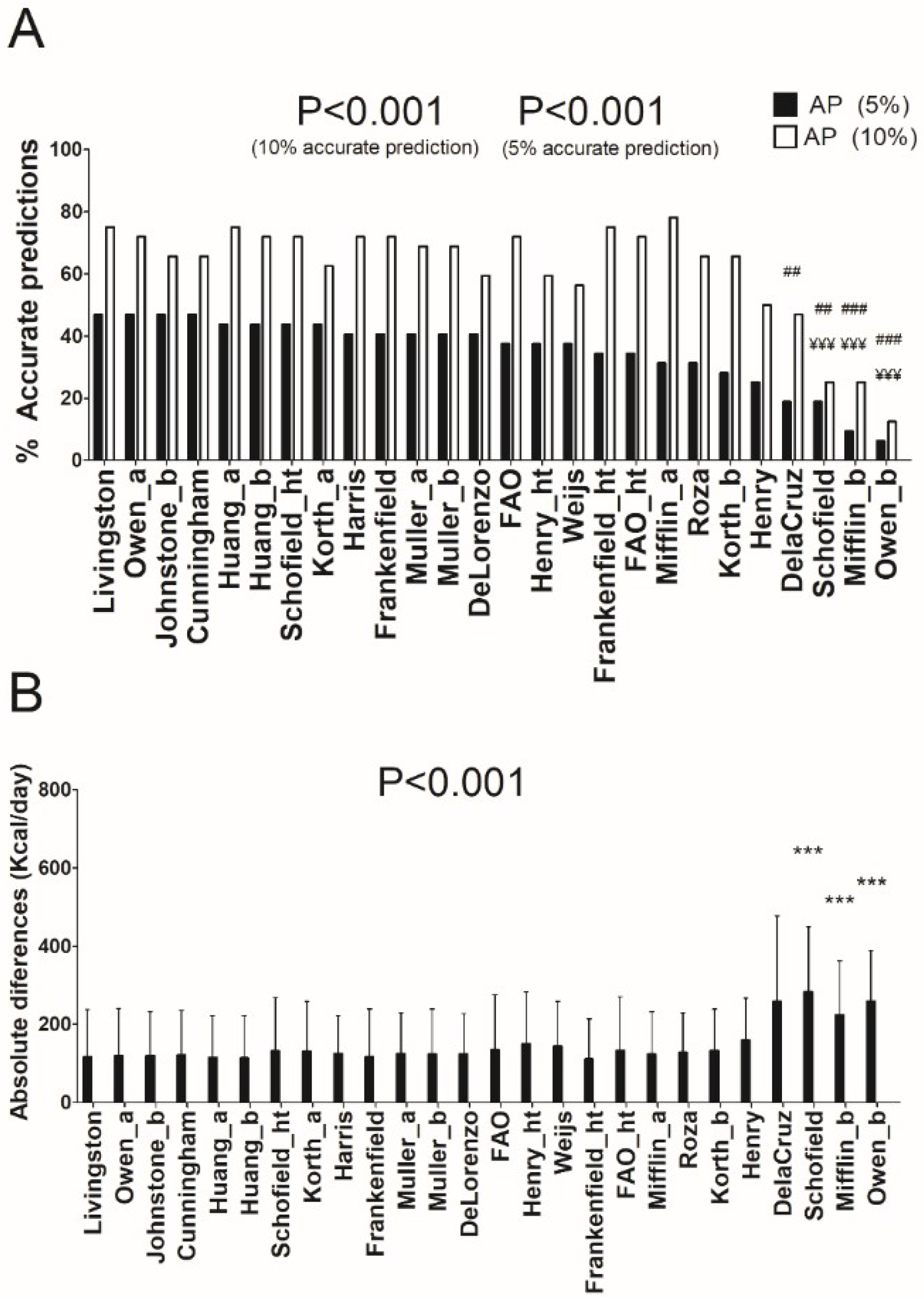
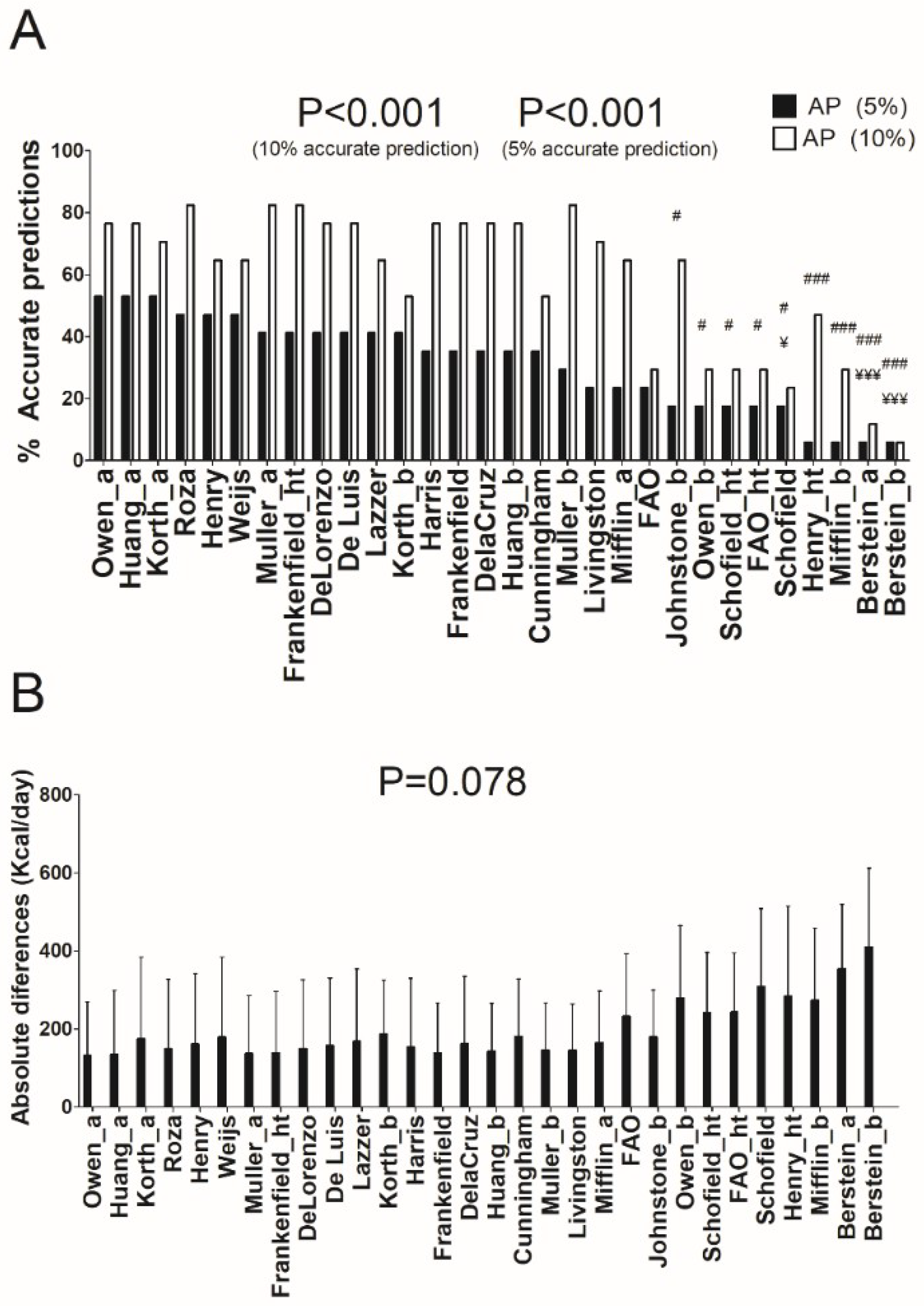

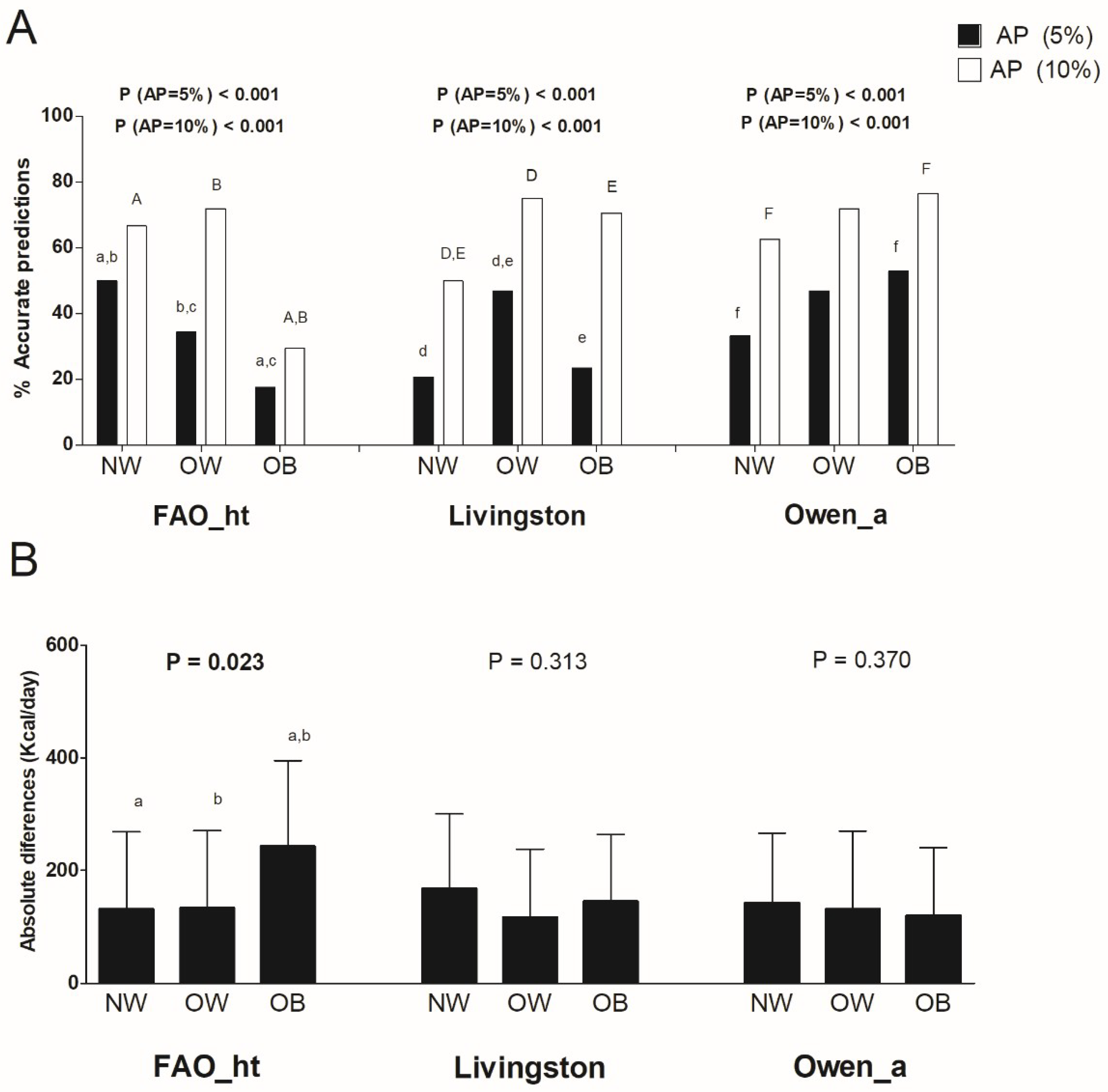
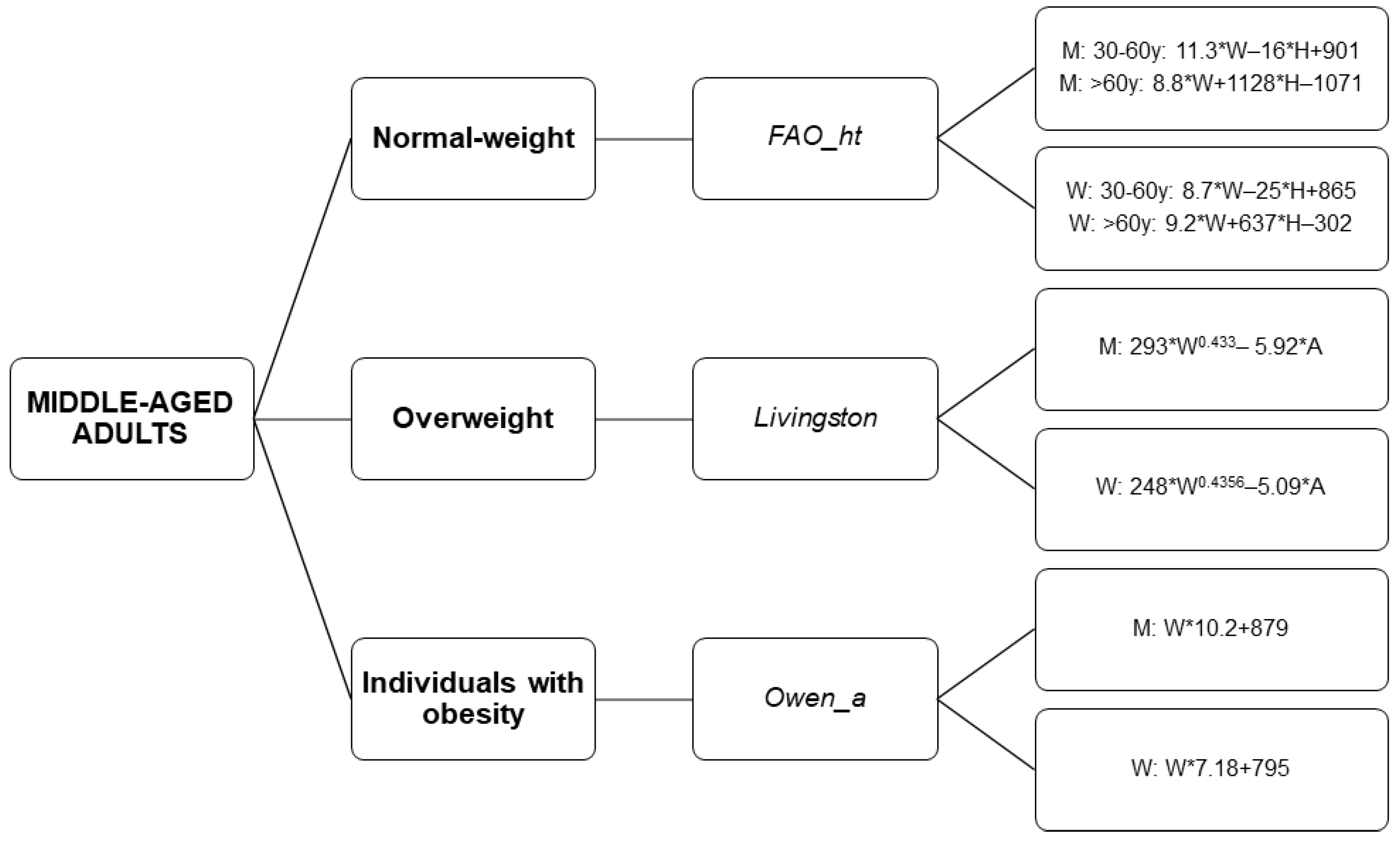
| All (n = 73) | Normal weight (n = 24) | Overweight (n = 32) | Individuals with obesity (n = 17) | |||||
|---|---|---|---|---|---|---|---|---|
| Men (n = 35) | Women (n = 38) | Men (n = 9) | Women (n = 15) | Men (n = 13) | Women (n = 19) | Men (n = 13) | Women (n = 4) | |
| Age (years) | 54.4 ± 5.3 | 52.9 ± 5.1 | 55.0 ± 5.4 | 53.1 ± 4.6 | 54.4 ± 5.8 | 53.1 ± 5.3 | 53.9 ± 4.9 | 51.8 ± 6.9 |
| Weight (kg) | 86.36 ± 11.05 | 66.36 ± 10.04 | 73.03 ± 5.68 | 58.94 ± 5.55 | 86.19 ± 5.98 | 68.40 ± 6.61 | 95.76 ± 7.73 | 84.46 ± 9.91 |
| Height (m) | 175.8 ± 6.5 | 160.9 ± 6.0 | 178.2 ± 5.0 | 162.2 ± 4.9 | 177.7 ± 6.6 | 159.8 ± 6.6 | 172.3 ± 6.2 | 161.6 ± 7.3 |
| Fat mass (%) | 34.59 ± 7.89 | 45.51 ± 7.51 | 28.35 ± 5.53 | 40.02 ± 4.46 | 33.03 ± 6.14 | 49.34 ± 7.62 | 40.46 ± 7.00 | 47.91 ± 2.03 |
| Fat-free mass (kg) | 56.04 ± 6.88 | 36.01 ± 6.54 | 52.28 ± 5.36 | 35.32 ± 4.02 | 57.77 ± 6.8.0 | 34.85 ± 7.20 | 56.92 ± 7.35 | 44.11 ± 6.47 |
| Lean mass (kg) | 53.41 ± 6.71 | 34.08 ± 6.37 | 49.70 ± 5.15 | 33.42 ± 3.97 | 55.13 ± 6.60 | 32.94 ± 7.03 | 54.27 ± 7.22 | 41.97 ± 6.08 |
| REE (Kcal/day) | 1796 ± 196 | 1291 ± 175 | 1763 ± 130 | 1238 ± 190 | 1806 ± 258 | 1291 ± 140 | 1808 ± 173 | 1495 ± 151 |
© 2018 by the authors. Licensee MDPI, Basel, Switzerland. This article is an open access article distributed under the terms and conditions of the Creative Commons Attribution (CC BY) license (http://creativecommons.org/licenses/by/4.0/).
Share and Cite
Amaro-Gahete, F.J.; Jurado-Fasoli, L.; De-la-O, A.; Gutierrez, Á.; Castillo, M.J.; Ruiz, J.R. Accuracy and Validity of Resting Energy Expenditure Predictive Equations in Middle-Aged Adults. Nutrients 2018, 10, 1635. https://doi.org/10.3390/nu10111635
Amaro-Gahete FJ, Jurado-Fasoli L, De-la-O A, Gutierrez Á, Castillo MJ, Ruiz JR. Accuracy and Validity of Resting Energy Expenditure Predictive Equations in Middle-Aged Adults. Nutrients. 2018; 10(11):1635. https://doi.org/10.3390/nu10111635
Chicago/Turabian StyleAmaro-Gahete, Francisco J., Lucas Jurado-Fasoli, Alejandro De-la-O, Ángel Gutierrez, Manuel J. Castillo, and Jonatan R. Ruiz. 2018. "Accuracy and Validity of Resting Energy Expenditure Predictive Equations in Middle-Aged Adults" Nutrients 10, no. 11: 1635. https://doi.org/10.3390/nu10111635
APA StyleAmaro-Gahete, F. J., Jurado-Fasoli, L., De-la-O, A., Gutierrez, Á., Castillo, M. J., & Ruiz, J. R. (2018). Accuracy and Validity of Resting Energy Expenditure Predictive Equations in Middle-Aged Adults. Nutrients, 10(11), 1635. https://doi.org/10.3390/nu10111635






